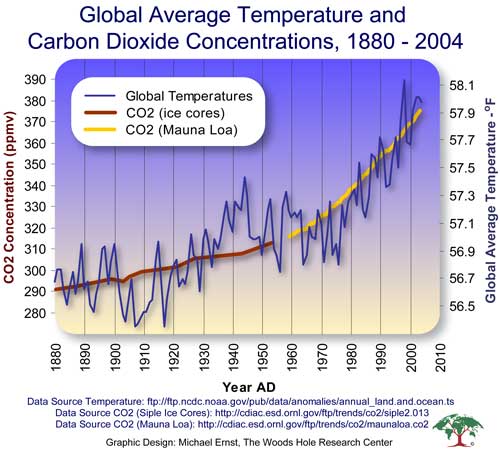
A rise in atmospheric carbon dioxide is mirrored by a rise in temperatures
Future Climate in the Great Basin
By Larry Hyslop

A rise in atmospheric carbon dioxide is mirrored by a rise in temperatures
The effects of climate change are evident in the Great Basin. Some change seems to be merely interesting, while some people may see a few instances of future change as good. Much of the predicted change, however, looks like it will aggravate some of this area’s largest problems.
Jeanne Chambers is a research ecologist for the US Forest Service’s Rocky Mountain Research Station in Reno. She outlines climate predications in an USFS publication titled “Climate Change and the Great Basin”.
The amount of carbon dioxide in the atmosphere is increasing, resulting in rising temperatures. Over the past 100 years, while we have kept good climate records, the Great Basin has warmed about one degree Fahrenheit. During the next 100 years, the prediction calls for a further rise of 3-9 degrees. Perhaps more important is the rise seen in nighttime low temperatures more than in daytime high temperatures. Nights are becoming warmer and the growing season between frosts is increasing. The probability of abnormally warm years has increased while the probability of abnormally cold years has decreased.
Annual precipitation has increased 6-16% over the last 50 years and the number of years having abnormally heavy precipitation have increased. Yet annual snow packs have decreased, since more precipitation arrives as rain and periods of winter snowmelt occur. Spring peak runoff is arriving 5-15 days earlier and plants are blooming earlier. Future predictions show little change in annual precipitation but the Great Basin is predicted to show even greater loss of annual snow pack.
Stream flows will exhibit noticeable changes. Higher winter flows will be followed by reduced and earlier spring flows. Summer and fall flows will also be reduced.
Crops may benefit from more atmospheric carbon dioxide and longer growing seasons. However, some plants do not need the help. Weeds and invasive plants such as cheatgrass will also benefit. The expansion of pinon-juniper woodlands may accelerate.
We will likely see more of our nemesis, wildfire. The predictions show longer fire seasons with more fires. Wildfires may be larger and exhibit more severe behavior. A further spread of cheatgrass will provide fine fuels to help fuel more wildfires.
Jeanne told me scientists use climate models to predict future trends based on the rise in carbon dioxide levels. Different models produce different results. The rise in future temperature is relatively easy to predict but the timing and amount of future precipitation is harder to project, since it is based on very complex global circulation patterns in our atmosphere. But all these predictions point to a more problematic future for the Great Basin.
Elko Daily Free Press, “Nature Notes”, 12/1/2011
© Gray Jay Press, Elko, NV
Return to Elko Nature Notes